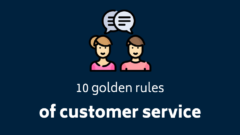Getting your new online store ready for action? Follow our checklist of eCommerce tips to make sure the start goes smoothly!
Opening an online store seems like an intimidating task at first. There’s so much to do that you may be reasonably worried that something important can slip your mind. Luckily, we thought that through, and prepared a complete checklist for opening a store with digital products! If you follow it, you won’t miss any essential milestone on your way to success.
1. Planning stage
Before you get to work, sit down and think. Establish a clear vision of your online business and then make it come true. Remember: failing to plan is planning to fail. Without a good strategy, you are like a babe in the woods.
- Find your market niche.
- Come up with a catchy and short business name. Check if a domain name you chose is available.
- Conduct market research and competitor analysis.
- Define your Unique Selling Point. Ask yourself: why should people buy from you instead of your competitors? It will be a starting point of your whole marketing strategy.
- Prepare a realistic budget.
- Plan your brand identity.
- Choose a product range for a start.
- Create a marketing strategy.
- Decide whether or not you plan to hire staff.
- Write down your business plan in details. Include all the deadlines and long-term goals.
2. Development stage
Now it’s time to take action. Decide if you do it all by yourself or if you’ll outsource the hard parts. Whatever you choose, do your best but keep your perfectionism at bay. First versions are always a bit awkward. Just make sure it works, and you’ll have plenty of time to refine the details after launch.
Legal
☐ Register your business according to regulations in your country. Apply for all the necessary business licenses and permits.
☐ Create a privacy policy for your store.
☐ Write down terms and conditions of using your services.
☐ Adjust your data protection system to GDPR if you sell in Europe.
☐ Get insurance for your business – better safe than sorry.
☐ Sign contracts with suppliers or choose to sell games with CodesWholesale without any agreements or term commitments.
Finances
☐ Get yourself a business bank account.
☐ Set up a PayPal Business account.
☐ Choose payment gateways for your online store.
☐ Find an accountant who’ll manage your ledgers, or register on an online accounting platform, e. g. Xero.
Website
☐ Choose an eCommerce platform. We recommend WooCommerce, Shopify, Magento, Opencart, or PrestaShop.
☐ Install the CodesWholesale plugin. It’s free!
☐ Configure the plugin to your needs.
☐ Buy a domain and hosting space, if necessary.
☐ Find a website template and customise it.
☐ Implement your visual identity on your website. Read the article about visual identity on our blog.
☐ Create site sections. Make navigation on your website as intuitive as possible.
☐ Decide whether you will enable creating customer accounts in your store or not.
☐ Learn how to create coupons, discounts, and sales in your store’s backend (most of the eCommerce platforms offer these functionalities in a standard plan).
☐ Test the checkout experience. Make it simple.
☐ Remember to make your website SEO-friendly.
☐ Check the responsiveness of your site. Make sure it displays well on all kinds of devices.
☐ Create product pages with many pictures and clearly visible CTAs.
Products
☐ Categorize your products.
☐ Import digital games with one click from CodesWholesale. If you also sell physical products, then find suppliers and rent warehouse space.
☐ Work out your pricing. For digital games, you can set up your profit margin in the plugin settings.
☐ If you sell in a dropshipping model of distribution, then test your product yourself before the first sale.
☐ Include various product delivery options for physical products. Digital goods will be delivered automatically via email.
☐ Create all product descriptions and assets. If you sell digital games, then just import all the assets alongside products.
☐ Enable or disable pre-orders of digital games.
☐ Decide if you allow customers to rate and review your products.
☐ Plan the strategy for up-sells, cross-sells, and bundles to maximize profits.
Community
☐ Create a loyalty program to ensure customer retention.
☐ Start an affiliate program for influencers.
☐ Choose social media channels and create your business profile there.
Other
☐ Set up a risk score value in the CodesWholesale plugin to protect your business from scammers. Read more about risk score on our blog.
☐ Create business email addresses. Usually, it’s hello@domain.com, support@domain.com and noreply@domain.com, etc.
☐ Write a comprehensive FAQ so clients can find information themselves before they get in touch with your support team.
3. After the launch
So after a marathon of work, the store is finally live, and you’re more than ready to sit back and relax, right? Bad news. It’s not over. To start making money, you need to promote your store to its target audience. People won’t buy from you if they don’t know that your store exists. Luckily, if you sell games with CodesWholesale, marketing is the only thing you’ll need to worry about from now on. Everything else happens automatically.
Marketing
☐ Tell your friends and family about your business. Word-of-mouth can work wonders for small stores.
☐ Set up a Google Analytics account for your business to measure the effects of your marketing efforts.
☐ Start a blog and fill it up with interesting content to add value to your website.
☐ Plan running contests, discounts and sales.
☐ Start your social media activity.
☐ Promote your store online.
☐ Develop a newsletter routine.
☐ Choose channels for paid advertising.
☐ Look for unusual ways to promote your store.
About the author

- Elliot
- Content specialist and gaming enthusiast. Trained to be a philosopher. Interested in Deep Learning, scalability and startups.






